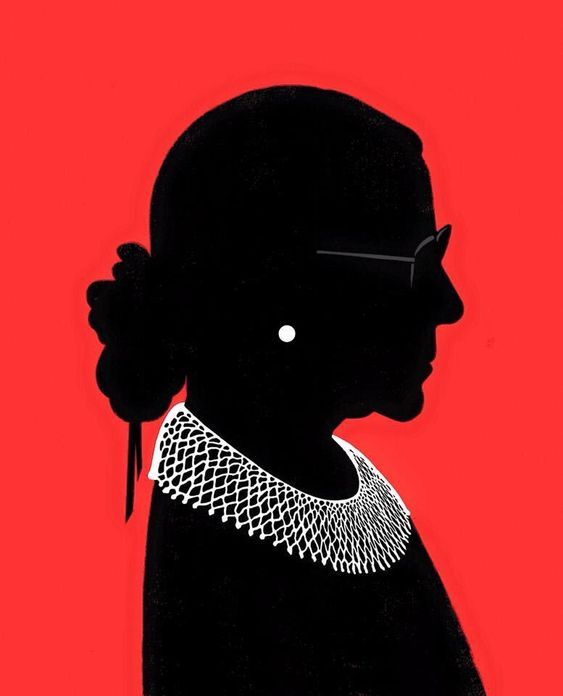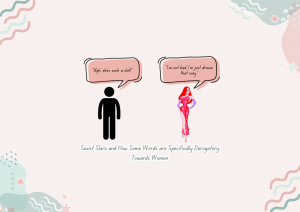Winner of the Spring 2019 StMU History Media Award for
Best Article in the Category of “Political History”
Being admitted into law school is difficult. Being admitted into Harvard Law is significantly harder. However, being admitted into Harvard Law as a female in the 1950s was near impossible. In the 1950s, a female’s hard work did not guarantee admission into any program. For the majority of Ruth Bader Ginsburg’s life, preferential treatment was always given to males, not only culturally and socially, but also in the eyes of the law. Nevertheless, she stood her ground in the face of adversity. The Notorious RBG has built her career on championing change in the law by fighting for equality for both sexes.

Ruth Bader Ginsburg, even in her early years, was no stranger to hardship. She grew up in a low-income Jewish family in Brooklyn, New York.1 It was during these years that Ginsburg’s mother taught her the most important of life’s lessons: independence. For Ginsburg, true independence is legal equality. She would be inspired by her mother’s life lesson, eventually, to fight for legal equality for all. Even with her mother’s passing while Bader Ginsburg was still in high school, her mother’s strong influence has followed her throughout her career.2
After the death of her mother the night before her high school graduation, Ruth enrolled for fall classes at Cornell University—where she eventually met her husband, Martin Ginsburg.3 After graduating from Cornell, Ruth and Martin moved to Kansas. While working for the Social Security Administration, she became pregnant. Despite her efforts to conceal her pregnancy, her superiors found out and demoted her—this would not be the only time Ginsburg would experience discrimination based on her gender.4 After her husband finished his time in the army, they both set their sights on law school. At the time of her admittance to Harvard Law in 1957, there was a grand total of eight women accepted into the program out of more than 500 students. During her first year of law school, Ginsburg and her women peers had dinner with the dean of the law school, Erwin Griswold. It was at this dinner that Griswold boldly asked the women in her class, “how they could justify taking the place of a qualified man?”5 That same year, her husband was diagnosed with testicular cancer. To support him, she completed her class responsibilities while helping him with his. While most of RBG’s law studies were completed at Harvard, she had to finish at Columbia. She fought to have her degree from Harvard, as there was a precedent for students’ to have their diploma from the school they had completed the majority of their studies. Nevertheless, Dean Griswold denied her request to have her LLB come from Harvard Law.6 When Bader Ginsburg graduated from Columbia Law in 1959, she was ranked number one in her class.7 Despite this fact, she was not hired by a single law firm in New York City and ended up as a professor at Rutgers’s Law School. As a law professor, she was able to take on any case she wished. She taught for years before taking on her first case, a tax law case in which a man was the victim of gender discrimination by the hand of the federal government.
RBG argued on behalf of Charles E. Moritz, alongside her husband, with the aid of the American Civil Liberties Union, Moritz v. Commission of Internal Revenue. It was during this lesser-known case, her first litigating case, that she first showcased her passion. In her early years, RBG’s mother had instilled in her a flexible perspective of the world, because people could take on many roles. To her, it made sense that bachelor Moritz should be afforded a tax break so he could be given the opportunity to take care of his mother. RBG believed this despite what society’s gender roles dictate that Moritz should do. During this first case, Bader Ginsburg was able to challenge institutionalized sexism, which at the time was legal. It is noteworthy that in her first case, her opposing counsel was one of her law professors from Harvard, Bozarth, and more importantly Dean Griswold of Harvard Law. Despite her skill and her impressive ability to write a perfect brief, she was still being underestimated by not only her legal foes and the court, but also by her own peers. For Bader Ginsburg, there was so much more than Mortiz’ $328.80 at stake.8 The future of legal gender discrimination was at stake. Up until this point, there were hundreds of laws differentiating citizens based on their gender, which was wrong and unethical to Bader Ginsburg. This is where her voice and ability to advocate for equality was able to ring loudly for the first time in the court of law–the unanimous decision by the 10th Circuit Appellate Court by Judge William Judson Holloway Jr. decided that differentiating a tax break on the basis of sex was in fact unconstitutional.9
In her role as lead counsel for the ACLU Women’s Rights Project, Ginsburg developed an effective strategy to achieve lasting results. Her strategy was to pick cases that were winnable and would set precedents to chip away at the legal barriers imposed on the basis of gender.10 In Kahn v. Shevin, for example, she represented a widower who believed he should be entitled to a Florida tax exemption that was usually only granted to widows. Later on, in Weinberger v. Wiesenfeld, Bader Ginsburg argued on behalf of a widower whose schoolteacher wife had been the family’s primary breadwinner. In all of these cases, while Bader Ginsburg, one of the most qualified attorneys of our time, was without a doubt underestimated at every single step.

Bader Ginsburg posing with her family members in the US Supreme Court | Courtesy of CNN
It was not until 1993, during the Clinton Administration, that she was nominated to the United States Supreme Court. She was appointed as the second woman ever and the first Jewish woman to serve on the United States Supreme Court.11 Her nomination and appointment to the United States Supreme Court finally gave Bader Ginsburg the platform that she needed to be able to interpret and read the letter of the law in a manner that would be fair. She could contribute to providing equality and protection under the law for all, which is what she had been fighting for her entire career as an attorney.
The Virginia Military Institute had a long-standing proud tradition and policy of only allowing the admission of men into the institution. The United States brought a case against the institution, stating that their tradition of gender discrimination violated the equal protection clause of the Fourteenth Amendment. This would be the first case that Bader Ginsburg would hear on the Supreme Court. United States v. Virginia, 518 U.S. 515 (1996), was a momentous case in which the Supreme Court of the United States struck down the long-standing male-only admission policy of the Virginia Military Institute (VMI) in a seven to one decision.12 Bader Ginsburg wrote, “a prime part of the history of our Constitution is the story of the extension of constitutional rights and protections to people once ignored or excluded.” Here, “there is no reason to believe that the admission of women capable of all the activities required of VMI cadets would destroy the Institute rather than enhance its capacity to serve the ‘more perfect Union.’”13 This case was the culmination of all of Bader Ginsburg’s trials and tribulations, which pushed her to work harder not for herself but to create a better world for the generations to follow her.

Being a woman in this world has never been easy, but women like Ruth Bader Ginsburg have become a beacon of hope for women everywhere because of her strong advocacy for equality no matter the gender, race, or religion. Ruth Bader Ginsburg, the second woman ever to be appointed to the United States Supreme Court, changed the momentum of the legal field for women. She has become an icon and inspiration to all women whether they are in the legal realm or not. Currently the oldest Supreme Court Justice, Ruth Bader Ginsburg has earned a reputation as a powerful voice for civil rights and gender equality. It is impossible not to be inspired by The Notorious RBG’s iconic determination and drive, which led to her historic appointment.
- Jane Sherron De Hart, Ruth Bader Ginsburg : A Life (New York : Alfred A. Knopf, 2018), 24-25. ↵
- Jane Sherron De Hart, Ruth Bader Ginsburg : A Life (New York : Alfred A. Knopf, 2018), 29-55. ↵
- Jane Sherron De Hart, Ruth Bader Ginsburg : A Life (New York : Alfred A. Knopf, 2018), 69-74. ↵
- Jane Sherron De Hart, Ruth Bader Ginsburg : A Life (New York : Alfred A. Knopf, 2018), 109-114. ↵
- Jane Sherron De Hart, Ruth Bader Ginsburg : A Life (New York : Alfred A. Knopf, 2018), 124. ↵
- Jane Sherron De Hart, Ruth Bader Ginsburg : A Life (New York : Alfred A. Knopf, 2018), 133. ↵
- Jane Sherron De Hart, Ruth Bader Ginsburg : A Life (New York : Alfred A. Knopf, 2018), 146. ↵
- “Moritz V. Commissioner Of Internal Revenue, 55 T.C. 113.” (1970), Casetext. https://casetext.com/case/moritz-v-commissioner-of-internal-revenue. ↵
- “Moritz V. Commissioner Of Internal Revenue, 55 T.C. 113,” (1970), Casetext. https://casetext.com/case/moritz-v-commissioner-of-internal-revenue. ↵
- Jane Sherron De Hart, Ruth Bader Ginsburg : A Life (New York : Alfred A. Knopf, 2018), 154-175. ↵
- Jane Sherron De Hart, Ruth Bader Ginsburg : A Life (New York : Alfred A. Knopf, 2018), 190-203. ↵
- “United States V. Virginia Case Summary,” 2017. University of Hawaii School Of Law Library. Https://library.law.hawaii.edu/2017/01/23/united-states-v-virginia-case-summary/. ↵
- “United States V. Virginia Case Summary,” 2017. University of Hawaii School Of Law Library. Https://library.law.hawaii.edu/2017/01/23/united-states-v-virginia-case-summary/. ↵



101 comments
Micheal Baladez
Before reading this article, I had no earthly idea who Mrs. Ruth Ginsburg was. However, through the reading I came the conclusion that Mrs. Ginsburg was truly a argumentative powerhouse. Despite this, she would get people who held a slight stigma that she wasn’t worthy of her career. However, time and time again, she demonstrated to those who doubted her just how effectively she could perform her judicial duties by only presenting her record in oral arguments. Until her death in September 2020, Mrs. Ginsburg was one of the most active questioners on the judicial bench. May she rest in peace, and may the spirit of her practices not fade from the halls of the supreme court. Amazing article!
Shriji Lalji
This is a very well written article and does a good job of outlining Ruth Bader Ginsberg’s life. She is an absolutely inspiring woman. Her hard work and persistence has been able to progress society to a more equal world for all. However high the odds were stacked against her, she succeeded in making a positive change for minorities. We have yet to see who is appointed and how they compare to RBG.
James Davis
Reading this honestly made me admire her even more. She is/was an incredible role model and woman. Her advocation for social justice, equality and much more has helped shape our country and we can only hope we find someone to take her place that keeps pushing us forward. Seeing how she overcame being underestimated shows just how strong she was.
Angela Perez
It has been a week since Ruth Bader Ginsburg passed, while reading this article I had tears in my eyes. She was a legend, an inspiration, and role model to so many. Her never ending battle for gender equality has left a legacy that is extremely important. It’s difficult to read this article with everything in the news cycle. It is terrifying to think that all of her hard work might be reversed.
Andres Garcia
With RBG’s recent passing, I felt compelled to read this article. Ruth Bader Ginsburg was truly a trailblazer. Her hard work and persistence allowed her to make a big difference in gender equality. Even though she had to face adversity because of her gender, Justice Ginsburg’s life set a precedent for the women who followed in her footsteps. Ruth Bader Ginsburg is undoubtedly an inspiration for women and men all around the country. She will be missed dearly.
Janie Cheverie
Ruth Bader Ginsburg was a huge advocate for gender equality, social justice, and women empowerment. This was an amazing article that was so well written while also describing all of the work she did throughout her life to achieve her goals and what she believed in. Due to her recent death, this article served as a good reminder of how she impacted so many lives and fought for her desires.
Lindsey Ogle
This is an amazing article. Ruth Bader Ginsburg was an advocate for so many people. She fought for social justice, gender equality and women empowerment. This article was very well written and described her life and the work that she did for her time on earth. Since her recent death, this was a good article to read this week to really learn about her and how she impacted so many people’s lives.
Maya Simon
Mrs. Ruth Ginsburg proved time and again that she was a force to be reckoned with, and those who doubted her capacity to effectively complete her judicial duties needed only to look at her record in oral arguments, where she was, until her death, among the most avid questioners on the bench. Rest In Peace to Mrs. Ginsburg, great article!
Kendall Guajardo
Very good article! RBG was certainly ahead of her time and very inclusive when society deemed her out of the realm of what they expected her to be, ironically discriminating against her based on her gender. Her passing is very tragic when our society is as polarized as ever. She is so inspiring for women wanting to pursue not only the legal field, but in any field where they face active discrimination when they are in the roles that they fought for. Oftentimes people miss the mark when it comes to gender equality and claim that it is as simple as harassment in the workplace or wage gaps, when in fact gender discrimination effects many people in such different ways. She fought for everyone and for our constitution to be honored in all its aspects. A very resilient and clear-minded justice who will have left her mark on the world in ways her professors and Griswold wish they had. The cases she worked on are so important and life-changing for women everywhere.
Alicia Martinez
Ruth Bader Ginsburg was a prominent advocate for social justice, gender equality, and women empowerment. This article did a great job at describing her life and the importance of her contribution to society as Jewish women who found success and became a Supreme Court Justice. The examples of how Ginsburg was “underestimated” really provided a nice theme for this article.